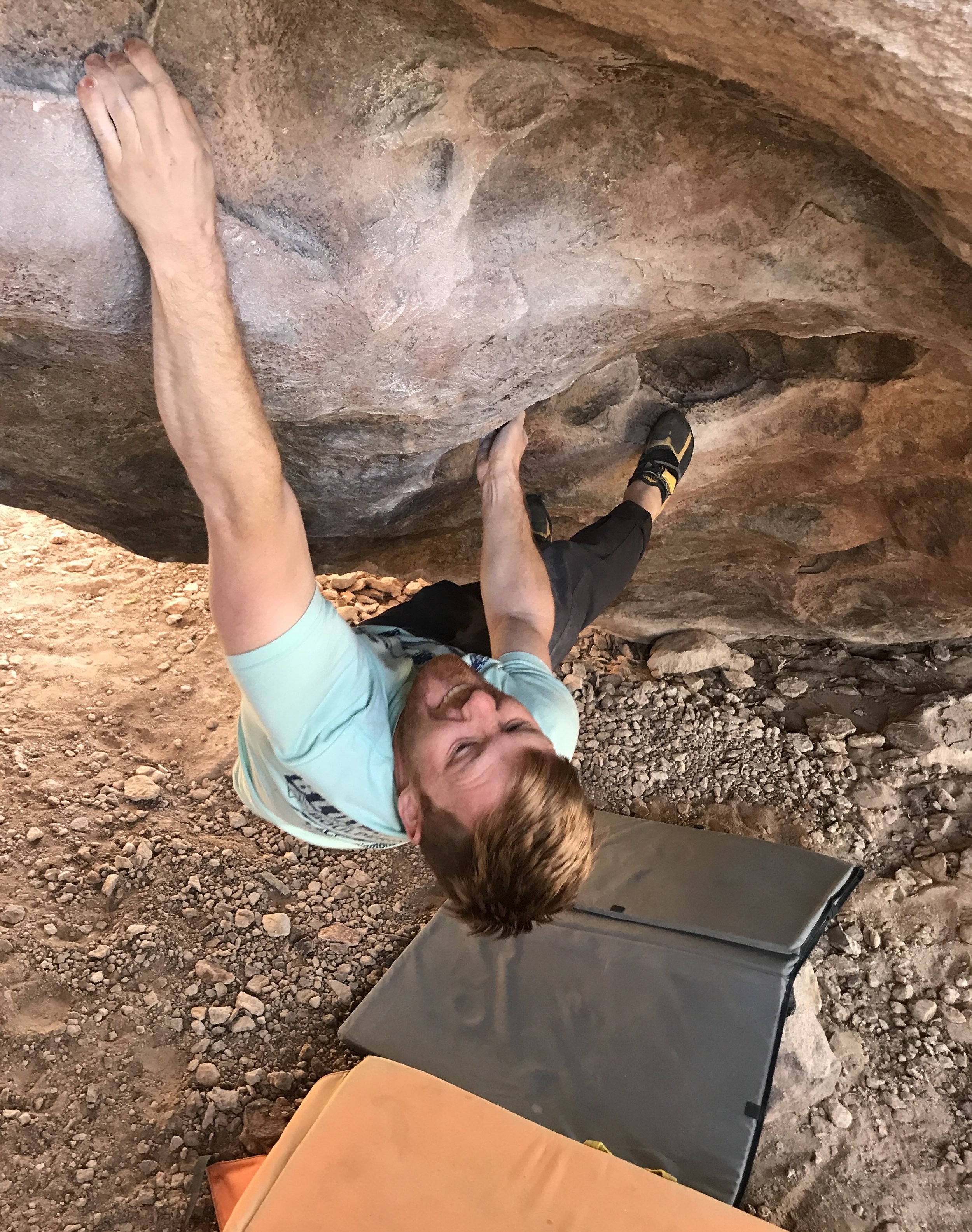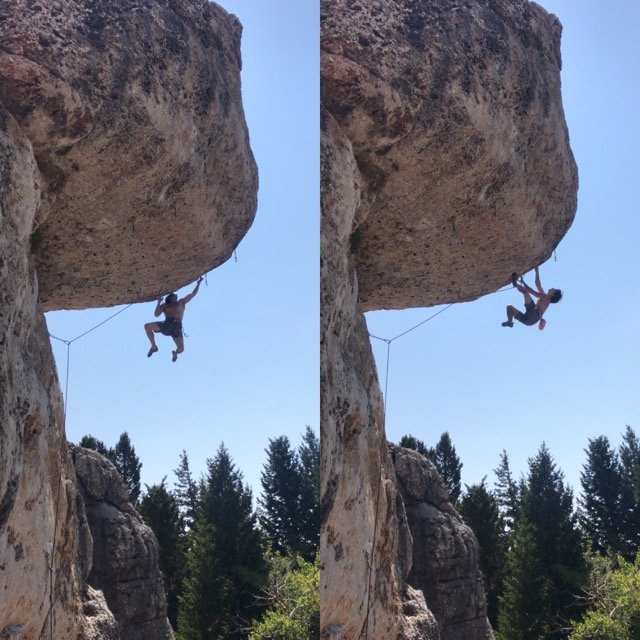Build In Wins
The belief that you are getting better at climbing is one of the most important ingredients in actually getting better at climbing.
We’ve all experienced a hot streak. You knock out a few hard climbs back-to-back, and suddenly you feel like a different person. You start seeing climbs with new eyes. Boulders that looked impossible last week now have you thinking, “I should try that.” The amount of attempts it takes to go from “I’m working out the moves,” to “I’m here to send,” drops dramatically.
Who is this confident person and why can’t they be around all the time?

Brian Towner looking to build in a win with Full Service (V10), Hueco Tanks, Texas.
The effects that confidence and momentum have on your performance in a climbing season can’t be overstated. The more momentum you build, the less you will be deterred by the speed bumps that will inevitably pop up along the way. The best part is that you can create momentum in your climbing with some degree of consistency by building wins into your season.
First, you need to pick the right building blocks. My recommendation for most people is to start small and build up from there. Using boulders as an example, try to find a few climbs that will take you 3-4 sessions to send each. That’s enough time that you have to work hard to send them, but not so long that you feel bogged down. For routes, this range tends to be somewhere in the 6-10 attempt zone. It’s okay if the climbs end up happening a little faster or slower than those recommended ranges. It takes some practice to get a feel for how long climbs will end up taking you.
Second, see these climbs through to completion. It’s easier now than ever to dabble with climbs but never send them. Gym turnover is the shortest it’s ever been, and commercial boards have thousands of climbs in their apps. Don’t be tempted by the shiny new climbs. Pick a project and finish it.
Once you’ve done a few of these you’ll start to feel more confident with what you can do. The next step is important. Keep doing those 3-4 session boulder projects, but dedicate less of your overall time to them. Spend larger portions of your time working towards things that seem just out of reach. Add in a harder project to the mix. Try to flash or onsight grades that seem a little intimidating.
Most people lose their confidence and need to rebuild their momentum because they’ve fallen into one of two categories:
Category 1: Everything Happens Fast
These people:
Either send a climb in 1-2 sessions or not at all.
Love volume climbing and novelty.
Often lack the feeling of true accomplishment because most of their sends come from such short efforts.
Struggle to know where the upper end of their abilities are.
Know that they should be able to send harder if they commit to a project.
Often get discouraged when trying harder climbs because they are used to quick success.
Category 2: The Mega Projectors
These people:
Don’t hesitate to put in 10+ days to send a climb.
Often struggle to truly try hard because they are used to dialing things down to a level where it’s comfortable.
Fall apart when unexpected issues come up on-route.
Have amazing persistence, but when it runs out, they crash hard.
Often go weeks or even months without having success.
Can feel drained after a long campaign to send a project. As great as it was to succeed, they will need a break before they start the process over.
It’s okay to have chunks of time where you focus on easier moderates or strictly focus on harder projecting, but if you want consistency in your climbing, then the meat and potatoes of what you work on should live somewhere in the middle. These climbs should be too hard to send quickly or mindlessly, but not so hard that you have long gaps between success and tank your momentum.

I never thought I’d be recommending this, but some of y’all should be putting less effort into becoming technically better climbers.
Do you really have terrible willpower? Or are you surrounded by distractions and obstacles?
Giving artificially low grades to climbs increases their perceived value for our training and development. The more something is mis-graded the more we naturally want to prioritize it.
Climbing starts off as this self-feeding cycle that has you wishing you could climb seven days a week. What happens when this cycle stops bringing improvement though?
Use strength to leverage every other aspect of your climbing, not replace them.
If everything you do is a finger workout, then when do your hands get a chance to recover?
There is a common theme between a grilled cheese sandwich and good training advice.
The more accurately we define our problems, the more approachable it will feel to find solutions.
Maybe the most understated way of getting better is to build fallback successes into your plan.
How much time should climbers spend becoming more well rounded vs. improving their strengths?
As cool as assessments and standards are, they can easily leave people settling for “good enough” when they have the potential to do much more.
Being able to quickly recognize familiar sequences is a crucial ingredient to harder climbing.
It’s far more comfortable for us to blame ignorance for our lack of progress than it is to blame our own efforts.
Once you learn the power of good tactics it can be hard to step away from them.
Of all the people that I spoke with this year who were stuck in plateaus, many of them had the same thing in common: they climbed and trained alone.
The belief that you are getting better at climbing is one of the most important ingredients in actually getting better at climbing.
How many times have you gone up a route and felt overwhelmed, only to look back and realize that it’s not as intimidating as it initially seemed?
Most of us go into a training plan or an outdoor season with an expectation, but expecting results can make us brittle when problems arise.
Whenever there is a training article online or some tidbit of knowledge on social media, it’s important that you consider the context.
At a certain stage in climbing, the hand and foot beta you use stops being the deciding factor in whether or not you are successful.
The intermediate climber’s problem with perception starts to arise when they can’t recall all of the solutions they have attempted during the problem solving process.
If you want to get the most out of your skill work and practice, being able to remember what you tried is a great first step.
Well-intentioned brainstorming about improving ourselves can quickly devolve into avoiding the challenge in front of us.
7 years later, almost to the day, that Tommy and Kevin topped out the Dawn Wall together, we REWIND to this conversation about belief and partnership with Tommy Caldwell.
The belief that you are getting better at climbing is one of the most important ingredients in actually getting better at climbing.
Fame and authenticity don’t always go hand in hand. We’d love to believe that in climbing they always do, but that just isn’t the case.
My perception of what I was capable of, what could be possible, how hard I can push myself, the belief, the confidence, was all very much changed through a mere three weeks of training.
So often we don't believe we can do a route because of one difficult move. Now imagine dozens of those moves that take you years to unlock.


































Inspiration is intoxicating, but often fades as quickly as it shows up.